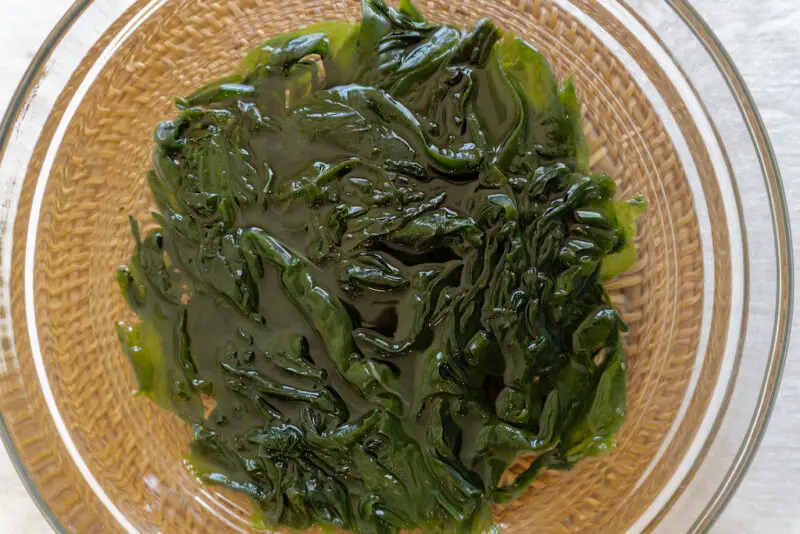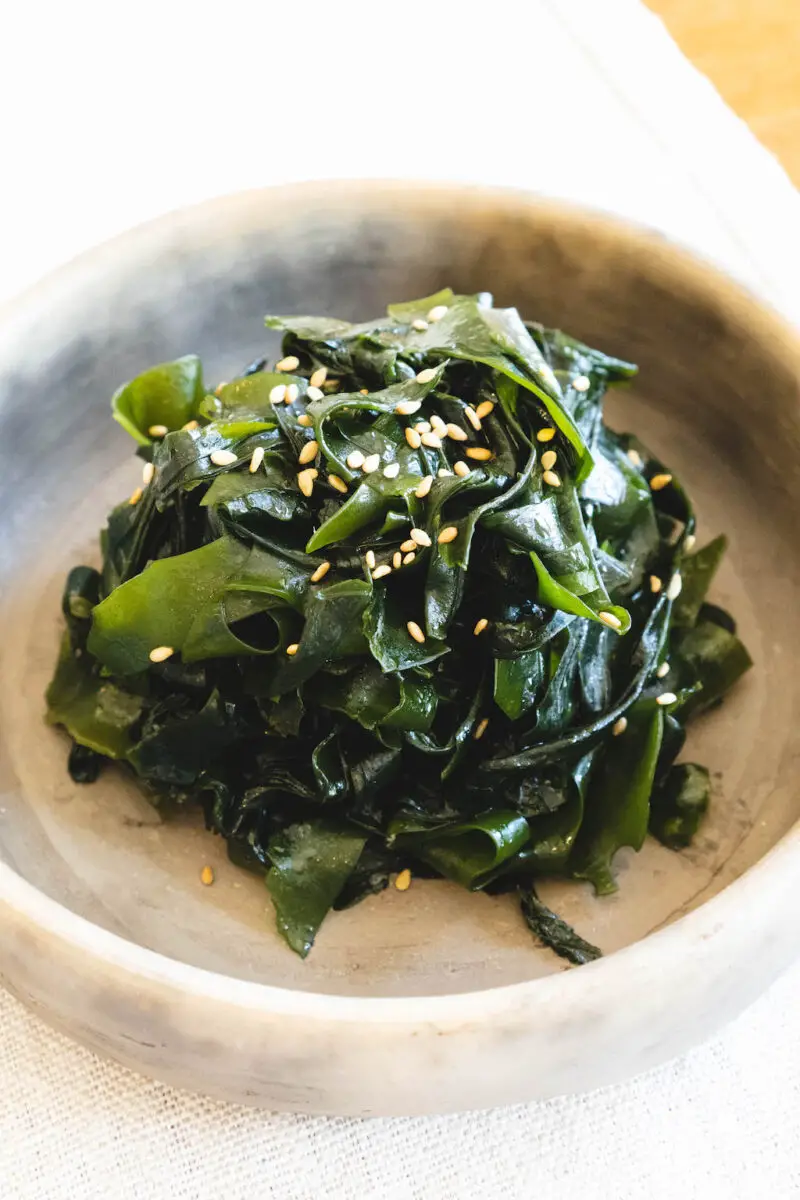This post may contain affiliate links. Please read my disclosure for details at the bottom of this page. As an Amazon Associate, I earn from qualifying purchases on this article about brown seaweed in Korean cuisine (miyeok). I hope you enjoy learning about the wakame variety of seaweed!
What Is Miyeok?
Brown Seaweed is a species of edible kelp (large brown algae or seaweeds that make up the order Laminariales) native to the colder, more temperate coasts of the northwest Pacific Ocean.
In English, people refer to this variety of kelp as brown seaweed or sea mustard. In Japan, people refer to this edible sea vegetable as ‘wakame.’ Then, in France, it is known as ‘wakamé’ or ‘fougère des mers,’ which translates to ‘sea fern.’ Finally, in South Korea, people refer to it as ‘miyeok’ (미역).
In grocery stores, this ingredient is packaged and sold dried, which allows it to have a longer shelf life. To cook with miyeok, prepare it by first rehydrating it for 30 minutes to an hour in warm water. Miyeok expands quite a lot, so when learning to cook with it, always prep less than you think is necessary.

Note to Be Confused With:
This variety of seaweed differs from the one used to make dried seaweed sheets (known as nori in Japanese or kim/gim in Korean). It also differs from the dried kelp known as kombu in Japanese or dashima in Korean. Dashima is the dried kelp used to help bring flavor to broth in both Japanese and Korean cooking.
- Learn more about dried seaweed (nori/kim/gim) sheets here
- Learn more about dried kelp (kombu/dashima) here
Miyeok in Korean Cuisine:
Once again, people in Korea refer to this the wakame variety of seaweed as ‘miyeok’ (미역).
Most commonly, people in Korea use this sea vegetable as a flavor ingredient in miyeok guk, a traditional seaweed soup served most commonly on birthdays.
Some Examples of Miyeok in Dishes Include:
- Miyeok Guk (미역국): Literally meaning ‘seaweed soup,’ people make this dish by cooking seaweed in a clear, thin broth. Often this soup also contains bite-sized pieces of stew beef or shellfish (such as clams). As I stated above, people in Korea consume this soup on their birthdays. Traditionally, hospitals and families serve miyeok guk to new mothers after childbirth–sea mustard contains a high amount of calcium and iodine, nutrients that are important for new mothers, especially those who are nursing. Then, the tradition continues as mothers make this dish every year for their children on their birthdays!
- Miyeok Namul (미역 나물): In English, we can translate this to ‘seaweed salad.’ People make this Korean side dish by stir-frying seaweed with a soy-based sauce.
If you rather not cook miyeok, you can eat it raw as a ssam (an ingredient used as a wrap with barbecued meat).

Brown Seaweed (Miyeok) Frequently Asked Questions:
Now that we learned about this Korean seaweed ingredient, I want to also answer some questions you may have about it! If I do not answer your question, feel free to leave a comment in the section below or email me at [email protected].
What Does Miyeok Taste Like?
Wakame kelp tastes subtly sweet with a strong ocean-like salty and umami flavor. When rehydrated, the seaweed has a bouncy, chewy texture.
Where Can I Buy This Ingredient?
Excitingly, you can buy this ingredient at many Western grocery stores nowadays! If you cannot find it at your usual local store, you can buy it at your local Asian market.
If you do not live near an Asian grocery store, you can easily find this ingredient for sale online!
Where to Buy Korean Ingredients Online?
Nowadays, there are many online options to choose from to order Korean food online. These websites are not limited to but include:
- Amazon
- H-mart
- Hanpoom
- Wooltari
How Do I Properly Store Dried Brown Seaweed?
I recommend keeping your dried miyeok in an air-tight storage container or plastic bag. Then, store it in a cool dark place like a pantry.
Once you rehydrate miyeok, store it in the refrigerator in an airtight container. This can stay in the refrigerator for a few days.
What Is a Good Miyeok Substitute?
Unfortunately, there isn’t a really good substitute for miyeok for specific Korean dishes. Miyeok has a different texture than other types of seaweed. Further, it reacts differently than other types of seaweed when rehydrated.
Thankfully, as I stated above, you can order this ingredient if you cannot find it in your local grocery store.
I Hope You Enjoyed Learning About Brown Seaweed in Korean Cooking!
In the end, I hope you enjoyed learning about the uses of brown seaweed in Korean cuisine. If so, let me know in the comment section!
If you would like to read more about cooking, you can find recipes as well as further Korean ingredient articles on my blog. I listed some of our favorite Carving A Journey recipes below! For reference, many recipes are influenced by my family’s blended Korean and Southern heritage.
Korean Ingredient Articles:
- Ginger in Korean Cooking (Saenggang)
- Bokbunja (Korean Blackberry)
- Lotus Roots (Yeongeun)
- Korean Dried Radish Strips (Mumallaengi)
Further Carving A Journey Recipes:
If you have any questions or comments, you can also email me at [email protected]. And, finally, I would love to hear from you through our social media as well! You can follow me at @carvingajourney on Instagram, Facebook, and Pinterest. I also started a vlog Youtube channel with my husband! Or, if you would like more articles like these, you can subscribe to the blog by joining the mailing list. Let me know if you try cooking Korean food using wakame seaweed (miyeok)! Thank you so much for stopping by!
Carving A Journey is a participant in the Amazon Services LLC Associates Program, an affiliate advertising program designed to provide a means for sites to earn advertising fees by advertising and linking to Amazon.com. Although we may earn commissions for our endorsement, recommendation, testimonial, and/or link to any products or services from this website, these opinions are my own and I fully support these products.

